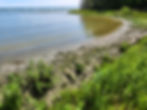On the road in Door County—between the beauty and the trouble (revised 8/6/24)
- Jane Elder
- Jul 2, 2024
- 4 min read
Updated: Aug 6, 2024

My husband Bill and I had back-to-back public talks in lovely Door County Wisconsin in late June—his, on water law and policy and implications for Wisconsin waters hosted by the Door County Environmental Council, and mine, on my book (Wilderness, Water & Rust) hosted by The Ridges Sanctuary.
In summer, the county is bustling with summer tourists intent on summer fun—from swimming and boating to just enjoying the expansive views across the bay or Lake Michigan. On a brief visit, we managed to fit in a hot-fudge sundae at Wilson's, Swedish pancakes at Al Johnson’s, and a visit to the always wonderful Edgewood Orchard gallery—Door County is such a special place.
At both events, local concerns about environmental impacts on the Bay of Green Bay and Lake Michigan were part of lively Q&A sessions. It was abundantly clear that people who are paying attention can see the changes in water quality, and the trends aren’t good.
At the first event, people raised concerns about the remaining presence of legacy pollutants (like PCBs) in bay waters, as well as the new threats from PFAS. A faint view of the far shore across the bay served as a reminder that one of the largest PFAS contamination sites in the Great Lakes was just over there, with clean-up efforts (including the contaminated groundwater) still underway, while the legislature holds approved clean-up funds hostage to their “no liability for responsible parties” agenda.
The conversation shifted away from the industrial chemicals when a woman pulled out her cell phone and showed photos of her once-lovely beach, now covered in a thick dark mat of rotting algae goo. Another talked about how the algae (Cladophora) had ruined her regular swims in Lake Michigan. Others spoke about the ongoing loadings of phosphorus into the bay from the upstream agricultural operations, and also about wells in Kewaunee County contaminated from E. coli—linked to the manure-spreading practices from CAFOs (concentrated animal feeding operations) also known as factory farms.
Fifty-two years after the United States passed its first modern Clean Water Act, we still don’t regulate agricultural water pollution like all other significant sources. Voluntary practices, while laudable, haven’t really worked, as we can see from the recurring dead zones and now early-season blooms and die-offs of green algae, and the occasional appearance of cyanobacteria (blue-green algae) which can release toxins into water.

On our second morning we hiked along a Lake Michigan shoreline trail in Newport State Park. At a shallow inlet, the first thing that got our attention was the stench, and there it was: gloppy dark clumps of rotting algae coating what should have been a sandy shoreline. Our hearts sank. The recent heavy rains had almost certainly flushed a fresh pulse of nutrients into the lake that helped boost the algal growth.
Quagga mussel shells covered the next beach we encountered. It is one thing to know that they are now the largest biomass in the Great Lakes; it is another to have thousands of shells crunching under our boots, reminding us of the impact of invasive species.

We tried to focus on the lovely vistas across the water, the pelicans soaring in the sky, and the scented cedar forest, but the environmental juxtaposition around us was dissonant.
You can understand why it is uncomfortable to be talking about sullied beaches and stinking algae in a tourism-dependent county, but being quiet about this threat won’t make it go away. Bill and I both admire Henrik Ibsen’s 1882 play An Enemy of the People, which is about democracy, truth, power, and pollution, (which recently enjoyed a Broadway revival). Ibsen’s protagonist pays a steep price for speaking out to protect human health, and thus threatening the local tourist economy. And yet, 142 years after Ibsen tried to bring these issues to light, communities still struggle with similar issues.
A spring of warm weather and intense rains makes this year exceptionally challenging. Algae thrive in warmer waters, and each thunderstorm flushes enormous amounts of topsoil and everything on it—the remains of spread manure, agricultural chemicals including phosphorus and nitrate-rich fertilizer, and debris—into rivers that flow into the lakes. What remains on land can percolate into groundwater.
Human decisions have caused these problems. Why can’t we change this? For polluted agricultural runoff, experts agree that changing field practices isn’t enough. As long as federal agricultural policy (and the economy it drives) remain largely the way Earl Butz designed it in the early 1970s, we won’t shift the incentives that maintain the systems that pollute public waters. These policies also leave the public to bear the costs twice—once in the subsidies, and again for the clean-ups, and perhaps once again, as we adjust to the economic and social impacts from the rapid loss of small family farms across the rural Midwest.
We can grow healthy food and have clean water and inviting beaches, but not without changing the practices that got us here in the first place.
Thank you Door County, for your hospitality and the natural beauty so many people treasure, and for sharing the stories that sound the warnings about the need for action. Let’s ask the hard questions about why our governments maintain policies and practices that threaten our health and the environment. We can anticipate push-back, and perhaps hostility to change, so be prepared, and as Ibsen cautions, "Never wear your best trousers when you go out to fight for freedom and truth.”